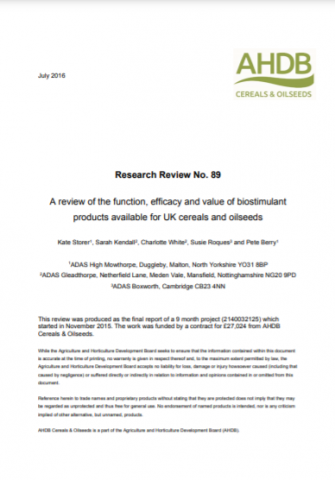Abstract
A wide range of biostimulant products are available for use on cereal and oilseed rape (OSR) crops. The term 'biostimulant' covers everything that can be added to the plant or soil to stimulate natural processes to benefit the plant, beyond fertilisation or pesticidal action alone. The aim was to review the mode of action, efficacy and value of commercially available biostimulant products and determine priority areas for research. A list of products currently available for UK cereal and OSR crops is included. In this review, biostimulants were classified into 11 distinct ‘product type’ categories as; seaweed extracts, humic substances (HS), phosphite and other inorganic salts, chitin and chitosan derivatives, antitranspirants, protein hydrolysates and free amino acids, non-essential chemical elements, complex organic materials, plant growth promoting bacteria (PGPB), arbuscular mycorrhizal fungi, non-pathogenic fungi and protozoa and nematodes. The review is divided into sections by these ‘product types’. Each section reviews the effects and modes of action for effects on different plant species and was not restricted to cereals and OSR as these crop species have been the subject of relatively few studies for some types of biostimulants. The level of evidence available for effects on plants is summarised to enable readers to quickly assess this information.
For all product type groups, there was at least some evidence that biostimulants can positively affect plant growth. Overall, there was evidence for 9 out of 11 of the product type categories to increase crop yields, although in many cases this was from experiments in either controlled conditions (e.g. glasshouse) or non-UK field conditions. Across the 11 product types, there was also evidence for increased nutrient uptake (N, P or other), plant function (hormone effects, anti-transpirant effects, delayed senescence or improved photosynthesis), abiotic stress tolerance (salt, alkaline, drought or cold stress), and biotic stress tolerance (induced or physical against pathogens or pests). The majority of product type groups had at least some evidence available for these effects on cereal crops, but consistently less information available for OSR crops. Many product types also had some level of a plant protectant role against pathogens or pests.
There is limited information available on the most appropriate rates, timings and management for UK cereal and oilseed rape crops. Microbial products in particular will require careful management, as a wide range of factors can affect inoculant success (e.g. inoculum storage, indigenous soil microbes, climate). Recommendations for managing these factors are also included in the review. Finally, key research gaps that should be targeted to enable exploitation of biostimulant products for the benefit of UK cereal and OSR crops are described.








